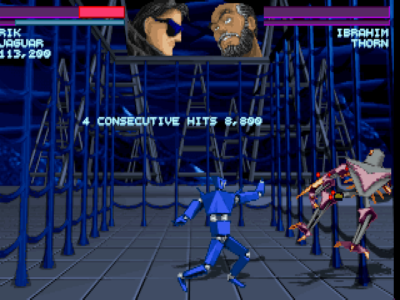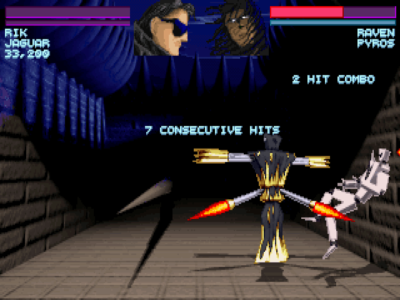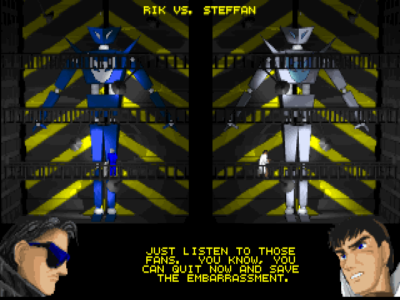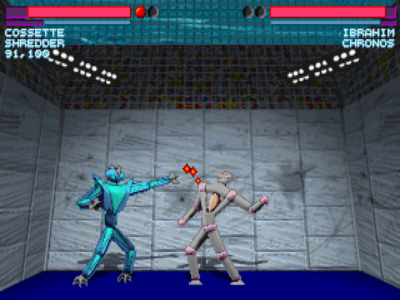
One Must Fall 2097
Written by: Rik
Date posted: November 14, 2009
- Genre: Action
- Developed by: Diversions Entertainment
- Published by: Epic Megagames
- Year released: 1994
- Our score: 7
Like it or not, there are certain genres that just aren’t all that suited to the PC. For example, beat ’em ups (or “fighting games”, in English) really belong on a console. Sure, a decent PC can do anything a current-gen console can do, but if you’re going to play Street Fighter, then you may as well do so with an Xbox and a bunch of mates gathered around the television.
Still, if that isn’t possible, for whatever reason, then at least these days you can plug a couple of 360 controllers into your PC, pretend it’s a console, and have a broadly equivalent experience. It’s a far cry from the days of getting a half-arsed conversion of Mortal Kombat with wobbly graphics that you had to play with the keyboard because your joypad didn’t have enough buttons. Sure, it was Mortal Kombat, on your PC, but it all seemed kind of pointless and difficult to get excited about.

Rik’s Jaguar (Transformer on a diet) delivers the knockout blow to Ibrahim’s Thorn (ridiculous giant bird thing). Take that, birdy.
In the face of such disappointingly inadequate console ports, some developers attempted to plug the gap in the market by coming up with their own fighting games, specially designed for the PC. Predictably, the majority of these were pretty crap as well, from the likes of Rise of the Robots, which boasted superficially impressive graphics, but was laughably limited in gameplay (you couldn’t even jump over your opponent and had to stay on one side of the screen the whole time) to FX Fighter, which claimed to be “just like” Virtua Fighter, in the same way that supermarket own-brand cola is “just like” drinking the real thing.
In amongst all the dross, though, was a low-profile gem that swiftly gained a cult following among PC gamers. One Must Fall 2097 (hereafter known as OMF) started life as part of the long-forgotten phenomenon known as shareware, which essentially involved a sizable but limited portion of a game being released to the public for free, with the rest of the content coming at a price [So, like a demo but bigger, then, you patronising dickhead? – FFG reader]. This was actually quite a good way of getting people interested in your games, although frequently the problem was that not enough of those people were interested enough in shelling out for the full game, which is probably why the whole thing eventually died out.
Anyway, as you can probably tell from the pictures, OMF is all about big robots fighting each other for no particular reason at all. Well, there is a reason, and it’s all explained in the manual, but it’s the usual sci-fi nonsense about multinational corporations controlling governments and military hardware being adapted for entertainment purposes. The main thing of relevance that you need to take in is the fact that the robots are controlled by human pilots who, instead of standing on the sidelines with a controller á la Robot Wars, take a more active role in proceedings by actually “becoming” the robot for the duration of the fight (don’t ask how it works, apparently some futuristic drugs and sci-fi machinery are involved).
What this means is that when it comes to selecting a combatant to represent you in the game, you not only have to choose a robot, but a pilot as well. As usual, they all have different strengths and weaknesses, although these can largely be summarised using categories marked “slow and powerful”, “fast and agile” and “average at everything”. While the pilots have handy bar charts to visualise their attributes, with the robots you largely have to guess based on their appearance and the odd clue given in the manual. Generally, though, the robots that resemble a slim human shape tend to be the quicker ones, while the ones that look like giant animals or pieces of construction machinery are the slow, lumbering hulks. In short, it doesn’t take too long to work it out, in the same way that you could pretty much guess the relative merits of Zangief and Chun-Li in Street Fighter II without even playing the game.

In Tournament Play, you get bonuses for consecutive hits and combos, although in this case I’m on the receiving end. You also have to pay for any damage to your robot, which is quite substantial if you happen to lose. Damn you Raven!
Speaking of which, OMF offers a couple of different game modes for the solo player, the first of which reflects those found in its arcade and console counterparts. You choose a pilot and robot and fight all of the others, with each fight getting progressively harder until you come across the big boss, who’s the hardest of the lot. If you’re anything like me (and for the purposes of this review, let’s pretend that you are – no matter how difficult that might be to accept) this mode will hold your attention for roughly the amount of time it takes to reach the point at which it gets really hard. Depending on your skill level, this could either be anything from a few minutes to the best part of an hour, but once you lose, you have to go back to the beginning to battle through all the easy fights again before you can have another go at the hard bit.
All of which is sort of fine, but it doesn’t do much for the longevity of the game, assuming (as it is fairly safe to do) that you don’t have a whole host of locally-based retro fighting fans who you can call up for a spot of multiplayer action. Fortunately, the other single-player mode, Tournament Play, has much more to offer over an extended period of time. This is effectively OMF’s career mode, which allows you to create your own pilot (you can select from a less-than-impressive total of three character pictures, which cast you as either a confused-looking blonde woman, a Manga representation of 80s singer Paul Young – in his heyday, of course – or an overweight sex pest), purchase the wimpiest robot available, and then fight in tournaments for prize money in the hope of upgrading your robot, rising through the ranks, and eventually becoming world champion.
As innovations go, it’s hardly earth-shatteringly original, and it’s the kind of thing that could easily feel ‘tacked on’ to an arcade-style single-player experience, but there’s no doubt that Tournament Play was intended as OMF’s main event. The structure of this mode is such that you spend the bulk of your time fighting opponents at roughly your skill level. Your next fight is always against the pilot ranked one place above you: if you beat him (or her) then you’ll take their place in the rankings, but if you lose, then your ranking goes down by one. It can mean a lot of time spent fighting the same two or three opponents until you improve, but on the positive side it does cut out the tedium of having to coast through easy victories and it also forces you learn about how your opponents fight and develop strategies to beat them. And if you ever manage to score a fluke victory to progress, you’ll soon be back down at your proper level until you learn to win properly.
You can spend literally hours with each tournament, and after a while it becomes less like your standard fighter and more like a sports game – grinding through fight after fight and psyching yourself up for the big matches while being careful not to underestimate opponents you’ve beaten already. Defeats are always frustrating, but it’s good to know that they don’t mean ‘game over’, either, and it’s good to have a slightly less intense game mode where your progress is saved automatically after each fight so you can come back to it, rather than the game demanding you beat it in one.
It’s features like Tournament Play that really make you see the clear advantage OMF has in being designed specifically for the PC. This also shows in the fighting itself, with a relatively simplistic control scheme that only requires one button for punch and one for kick. Double-jointed fighting game experts may disagree, but aside from the logistical simplicity (any controller, including the keyboard, provides perfectly serviceable play), I also found it allowed me to focus more on the fighting itself.
Normally, when it comes to this kind of thing I’m in the ‘try mashing the buttons and see what happens’ camp, but with OMF I was genuinely employing different tactics against different opponents – partly because I soon got the hang of the controls, and partly because ham-fisted hammering of the keyboard doesn’t actually work as a tactic. I also quite enjoyed the absence of a timer in Tournament Play, which allows you to take more of a patient approach to fights where necessary, making for some intriguingly cagey battles.
On the audio-visual side, I’m pleased to report that OMF comes across rather well for its age. The graphics are chunky but well designed and animated, with the menus and general presentation also of a high standard. Special mention must also go to the in-game music, especially the theme that plays on the main menu, which will lodge itself in your memory until you find yourself whistling it at work and swiftly have to think of an explanation to give to colleagues that’s much less embarrassing than the geeky truth.
It’s all been pretty positive so far (in fact, remarkably so – there must be something wrong with me today) but there are a few criticisms to level at OMF before we start getting too carried away. Firstly, for all of our joshing about the clichéd sci-fi plot, the snippets of information you get fed from time to time are enough to create a bit of intrigue, and you feel that if you get far enough through the Tournament mode you might get a bit more detail, but sadly the blanks remain largely unfilled. Secondly, there are only five arenas in which to fight, and to be frank only one of them, Power Plant, is any good. The others range from functional to pretty lame, the worst culprit being the desert arena that’s supposedly also used as a test area for fighter pilots (ie you get hit by machine gun fire every 20 seconds or so). You seem to rotate through the standard five during Tournament Play, too, and it would have been nice to have had one or two new ones for each tournament, perhaps even just for the final battle.
The main thing, though, is that however much you might praise the depth of the gameplay and the longevity of the tournament mode, the fact remains that OMF offers largely superficial, short-term thrills. There’s nothing wrong with that, of course, and connoisseurs of the genre may beg to differ, but even the best fighting games have a limited appeal, especially in single-player. Winning the World Championship in Tournament Play in OMF certainly takes some doing, but it’ll also take you several hundred individual fights to achieve, and sooner or later the repetitive nature of the whole enterprise is going to become all too apparent.
Make no mistake, though, OMF is among the best fighting games, especially on PC, where it stands head and shoulders above the rest of the PC-only fare. And, given that the chances of anyone else developing another old-school, side-on fighter specifically for the unfashionable office box in this day and age range from minimal to zero, it’s likely to stay there for some time. If you haven’t had a chance to check it out, I recommend that you do so, especially as the developers have very kindly released it as freeware.




 Posts
Posts